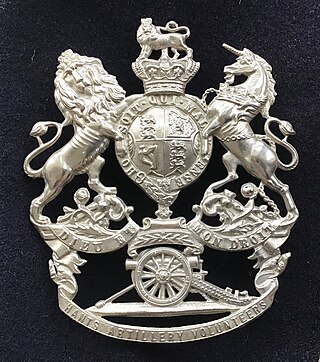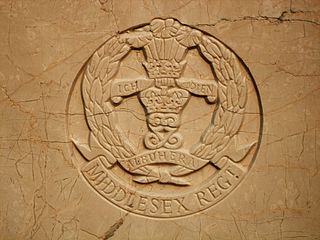The Robin Hood Battalion was a unit of the Volunteer Force of the British Army and Territorial Force, later the Territorial Army. The battalion served as infantry during the 1916 Easter Uprising in Dublin and then served on the Western Front during World War I. In the 1930s it re-roled as an anti-aircraft unit and served in World War II, including North-western Europe from June 1944 to May 1945.

The Liverpool Rifles was a unit of the Territorial Army, part of the British Army, formed in Lancashire as a 'Rifle Volunteer Corps' (RVC) in 1859, becoming a battalion of the King's Regiment (Liverpool) in 1881. It saw action on the Western Front in the First World War and later became a searchlight unit of the Royal Artillery in the Second World War.

The 1st Wessex Artillery was a volunteer unit of the British Army that existed under various titles from 1860 to 1971, including active service in Mesopotamia in World War I and North Africa and Italy in World War II.

The Finsbury Rifles was a unit of Britain's Volunteer Force and later Territorial Army from 1860 to 1961. It saw action at Gallipoli, in Palestine and on the Western Front during the First World War. In the Second World War, it served in the Anti-Aircraft (AA) role during the Battle of Britain and the Blitz, then in North Africa, Sicily and Italy.
The 7th Battalion, Essex Regiment was a volunteer unit of Britain's Territorial Army. First formed in the eastern suburbs of London in 1860, it served as infantry at Gallipoli and in Palestine during World War I. It later became an anti-aircraft (AA) unit of the Royal Artillery (RA), serving in North Africa and Italy during World War II.
The 6th Battalion, Essex Regiment was a volunteer unit of Britain's Territorial Army. First formed in the docks of East London in 1860, it served as infantry at Gallipoli and in Palestine during the First World War. It later formed searchlight units of the Royal Artillery (RA), serving during the Blitz.

The 9th Battalion, Middlesex Regiment was an infantry battalion of the British Army. Part of the Volunteer Force, later the Territorial Force, the battalion was part of the Middlesex Regiment and recruited from the north-western suburbs of London. It served as infantry in the Mesopotamian campaign during World War I and as an air defence regiment during and after World War II.
The 1st Northamptonshire Rifle Volunteers were a unit of the British Army raised from 1859 onwards as a group of originally separate Rifle Volunteer Corps (RVCs). They later became the 4th Volunteer Battalion of the Northamptonshire Regiment and saw action in the Gallipoli and Palestine campaigns during the First World War. Converted into a searchlight unit between the wars, they served in the defence of the United Kingdom and as an infantry regiment in liberated Norway during the Second World War. Postwar they continued in the air defence role until 1961 when they reverted to infantry as part of the Royal Anglian Regiment.
The Northamptonshire Battery, Royal Field Artillery was a unit of Britain's Territorial Force from 1908 to 1919. It served in the Sinai and Palestine Campaign during World War I. In World War II the battery fought in the Malayan Campaign and was captured at the Fall of Singapore.

The 1st Norfolk Artillery Volunteers was a unit of Britain's Volunteer Force raised in the County of Norfolk in 1859 as a response to a French invasion threat. It became part of the Territorial Force in 1908 and served under various designations as field artillery in Palestine during World War I, and as heavy anti-aircraft artillery in North Africa and Italy during World War II. It disappeared in a merger in 1955.
The 4th Battalion, Queen's Royal Regiment was a volunteer unit of the British Army from 1859 to 1961. Beginning from small independent units recruited in the South London suburbs, it was attached to the Queen's Royal Regiment and served in the Second Boer War, the First World War, and the Third Anglo-Afghan War. Before the Second World War, it was converted into a Royal Artillery searchlight regiment that served in the Battle of Britain and The Blitz. Later it became a light anti-aircraft gun unit serving on blockships in the Mulberry harbour during the Normandy invasion, and then defended the port of Antwerp in the closing stages of the war. Postwar it continued in the air defence role before rejoining the Queen's Regiment as infantry.
The 1st Manchester Rifles, later the 6th Battalion, Manchester Regiment, was a unit of Britain's Volunteer Force and Territorial Army recruited in and around Manchester. It served as infantry at Gallipoli, fighting with distinction at the Third Battle of Krithia, and in some of the bitterest battles on the Western Front in the First World War. After conversion into an anti-aircraft unit of the Royal Artillery between the wars, it defended Manchester, Scapa Flow and Ceylon during the Second World War and continued in the air defence role until 1955.

The 5th Battalion, York and Lancaster Regiment, was a unit of Britain's Territorial Force formed in 1908 from Volunteer units originally raised in the West Riding of Yorkshire in 1860. It served in some of the bitterest fighting on the Western Front during World War I, including the Somme, Ypres and the German spring offensive. Before World War II it was converted to air defence, in which role it served during The Blitz and in Burma, where it employed anti-aircraft guns for 'bunker-busting'. Postwar, it continued to serve in Anti-Aircraft Command until 1955.
The 1st Durham Rifle Volunteers, later the 5th Battalion, Durham Light Infantry, was a part-time unit of the British Army from 1860 to the 1950s. Beginning from small independent corps of the Volunteer Force recruited in County Durham and Teesside, it became part of the Territorial Force and served as infantry in some of the bloodiest actions of the First World War. Later it was converted to anti-aircraft units that served during the Second World War both in Home Defence and in North-West Europe. Its successor units continued in the air defence role in the postwar Territorial Army until 1975.
The 1st Lanarkshire Rifle Volunteers was a Scottish Volunteer unit of the British Army. Originally raised in Glasgow from 1859, it later became a battalion of the Cameronians. During World War I it served on the Western Front and in Ireland. Converted into an anti-aircraft regiment just before World War II, it served during The Blitz and in the campaign in North West Europe, and continued in air defence role in the postwar years until 1955.
The 4th Lanarkshire Rifle Volunteer Corps was a Scottish Volunteer unit of the British Army. Originally raised in Glasgow in 1859, it later became a battalion of the Cameronians. During World War I it served at Gallipoli, in Egypt and Palestine, and on the Western Front. Converted into an anti-aircraft regiment just before World War II, it served throughout the war and continued in an air defence role in the postwar years until 1950.
The 1st Linlithgowshire Rifle Volunteers was a Scottish unit of Britain's Volunteer Force raised in Linlithgow in 1860. It later became a cyclist battalion of the Royal Scots, which served in Home Defence and saw action in the North Russia Intervention force during World War I. Between the wars it was reduced to company strength, but just before World War II it was converted into an anti-aircraft (AA) regiment of the Royal Artillery (RA). This served in Anti-Aircraft Command during the Blitz and later distinguished itself in the Siege of Tobruk. It fought through the Italian Campaign and its successors continued in the postwar Territorial Army (TA) until 1967.

The Pembroke Royal Garrison Artillery was a part-time unit of the British Army that defended the coast of West Wales during both world wars. Although it never saw action in its coastal defence role, it manned a number of siege batteries of heavy howitzers for service on the Western Front and Italian Front in World War I.

The 1st Hampshire Artillery Volunteers and its successors were part-time coast defence units of the British Army from 1860 to 1967. Although the units saw no action, they protected the Portsmouth area in both World Wars and supplied trained gunners to siege batteries engaged on the Western Front during World War I. The unit continued in the Territorial Army after World War II.
The 1st Flintshire Rifle Volunteers, later 5th (Flintshire) Battalion, Royal Welch Fusiliers, was a Welsh unit of the British Army's auxiliary forces. First raised in 1860, it fought as infantry at Gallipoli), in Egypt and Palestine during the First World War. Converted to the anti-tank role, it fought in the Battle of France, the Western Desert and Italy in the Second World War. It continued in the postwar Territorial Army until amalgamated with a neighbouring unit in 1956.






